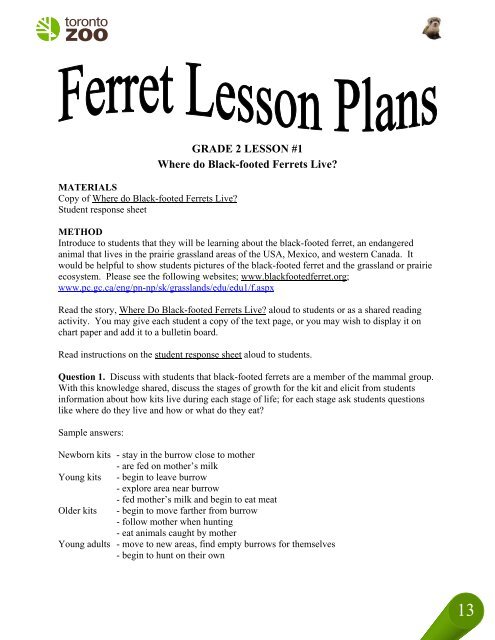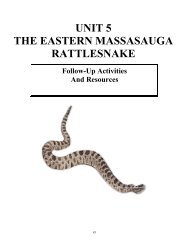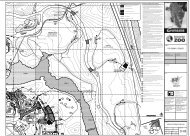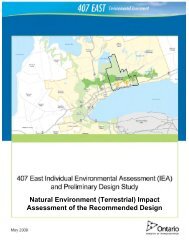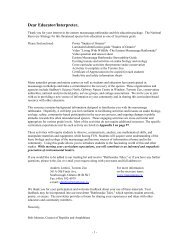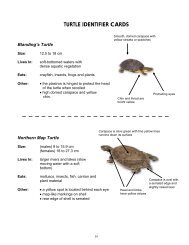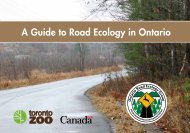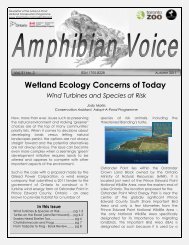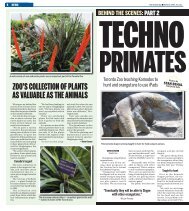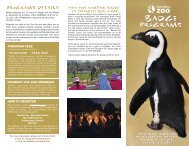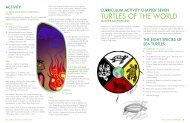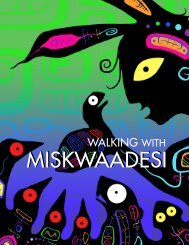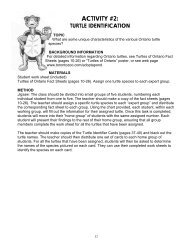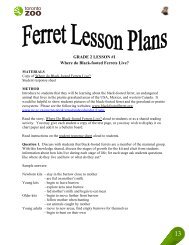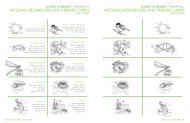GRADE 2 LESSON #1 Where do Black-footed Ferrets ... - Toronto Zoo
GRADE 2 LESSON #1 Where do Black-footed Ferrets ... - Toronto Zoo
GRADE 2 LESSON #1 Where do Black-footed Ferrets ... - Toronto Zoo
You also want an ePaper? Increase the reach of your titles
YUMPU automatically turns print PDFs into web optimized ePapers that Google loves.
MATERIALS<br />
Copy of <strong>Where</strong> <strong>do</strong> <strong>Black</strong>-<strong>footed</strong> <strong>Ferrets</strong> Live?<br />
Student response sheet<br />
<strong>GRADE</strong> 2 <strong>LESSON</strong> <strong>#1</strong><br />
<strong>Where</strong> <strong>do</strong> <strong>Black</strong>-<strong>footed</strong> <strong>Ferrets</strong> Live?<br />
METHOD<br />
Introduce to students that they will be learning about the black-<strong>footed</strong> ferret, an endangered<br />
animal that lives in the prairie grassland areas of the USA, Mexico, and western Canada. It<br />
would be helpful to show students pictures of the black-<strong>footed</strong> ferret and the grassland or prairie<br />
ecosystem. Please see the following websites; www.black<strong>footed</strong>ferret.org;<br />
www.pc.gc.ca/eng/pn-np/sk/grasslands/edu/edu1/f.aspx<br />
Read the story, <strong>Where</strong> Do <strong>Black</strong>-<strong>footed</strong> <strong>Ferrets</strong> Live? aloud to students or as a shared reading<br />
activity. You may give each student a copy of the text page, or you may wish to display it on<br />
chart paper and add it to a bulletin board.<br />
Read instructions on the student response sheet aloud to students.<br />
Question 1. Discuss with students that black-<strong>footed</strong> ferrets are a member of the mammal group.<br />
With this knowledge shared, discuss the stages of growth for the kit and elicit from students<br />
information about how kits live during each stage of life; for each stage ask students questions<br />
like where <strong>do</strong> they live and how or what <strong>do</strong> they eat?<br />
Sample answers:<br />
Newborn kits - stay in the burrow close to mother<br />
- are fed on mother’s milk<br />
Young kits - begin to leave burrow<br />
- explore area near burrow<br />
- fed mother’s milk and begin to eat meat<br />
Older kits - begin to move farther from burrow<br />
- follow mother when hunting<br />
- eat animals caught by mother<br />
Young adults - move to new areas, find empty burrows for themselves<br />
- begin to hunt on their own<br />
13
Question 2. Make it clear to students that the black-<strong>footed</strong> ferret lives in the prairies because<br />
this is where it finds all it needs to survive; food (prairie <strong>do</strong>gs), shelter (prairie <strong>do</strong>g burrows), and<br />
space (a place to raise its young).<br />
<strong>Where</strong> Do <strong>Black</strong>-<strong>footed</strong> <strong>Ferrets</strong> Live?<br />
<strong>Black</strong>-<strong>footed</strong> ferrets live in grassland areas where they hunt<br />
prairie <strong>do</strong>gs and use their burrows and tunnels to hide, sleep, and<br />
raise their babies. Grassland areas, or prairies, are large, flat<br />
areas that have very few trees and mostly grass species. The<br />
black-<strong>footed</strong> ferret is a type of weasel and is smaller and more<br />
slender than a cat. They have yellowish-brown fur, black feet, a<br />
black tail tip, and a black mask like a raccoon. Female ferrets<br />
have from one to seven babies in the spring. The babies, called<br />
kits, are born in a prairie <strong>do</strong>g burrow that the ferrets have taken<br />
over. Since ferrets are mammals, the kits are fed on their<br />
mother’s milk for the first part of their lives. After several weeks<br />
the kits will come out of the burrow and begin to explore areas<br />
nearby. During the summer they learn to hunt and to escape<br />
danger from other animals by following and watching their<br />
mother. By October, most kits have grown to full size and are<br />
ready to live on their own.<br />
14
Name:______________________________________<br />
<strong>Where</strong> Do <strong>Black</strong>-<strong>footed</strong> <strong>Ferrets</strong> Live?<br />
1) Draw one of the stages in the life of a black-<strong>footed</strong> ferret in the space below.<br />
2) In the space below explain why you think that the prairie is a good place for the black-<strong>footed</strong><br />
ferret to live.<br />
________________________________________________________________________<br />
________________________________________________________________________<br />
________________________________________________________________________<br />
________________________________________________________________________<br />
________________________________________________________________________<br />
________________________________________________________________________<br />
15
<strong>GRADE</strong> 2 <strong>LESSON</strong> #2<br />
How are <strong>Black</strong>-<strong>footed</strong> <strong>Ferrets</strong> Adapted to Their Environment<br />
MATERIALS<br />
Copy of How are <strong>Black</strong>-<strong>footed</strong> <strong>Ferrets</strong> Adapted to Their Environment?<br />
Student response sheet<br />
METHOD<br />
Review with students concepts covered in lesson 2.1, namely;<br />
- black-<strong>footed</strong> ferrets are mammals that live in grassland areas that have few trees<br />
- they hunt prairie <strong>do</strong>gs and use prairie <strong>do</strong>g burrows as their homes<br />
- young are raised in the burrows and learn to survive by watching their mother<br />
Tell students that in this lesson we will learn more about how black-<strong>footed</strong> ferrets live.<br />
Introduce the idea that every animal has ways that they live and behave that help them to survive<br />
in their own environment. The things that help the black-<strong>footed</strong> ferret survive in the prairie<br />
grasslands are called adaptations.<br />
Read the student text How are <strong>Black</strong>-<strong>footed</strong> <strong>Ferrets</strong> Adapted to Their Environment together as a<br />
shared reading activity (make and distribute copies of the student text or copy it onto chart paper<br />
and retain for later reference). You may need to review vocabulary with students before hand;<br />
camouflage, predator, badger, keen, burrows.<br />
Discuss the adaptations of the black-<strong>footed</strong> ferret to its environment. Go through the text again<br />
and guide students in identifying things that are part of the ferret’s physical make-up, its<br />
appearance, or behaviour that help it survive. Guiding questions would be things like…<br />
- Does this help the ferret to get food? How?<br />
- Does this help the ferret to raise its young? How?<br />
- Does this help the ferret avoid being caught by other animals that might hunt it? How?<br />
As this discussion progresses note adaptations in chart form using a table. A completed table is<br />
included for reference. You may wish to complete a class chart or use the included student<br />
response page to have students complete their own chart.<br />
In concluding the lesson, note that the black-<strong>footed</strong> ferret is well adapted to its environment and that<br />
this is what we see when we study any plant or animal in nature.<br />
16
How are <strong>Black</strong>-<strong>footed</strong> <strong>Ferrets</strong> Adapted to Their<br />
Environment?<br />
<strong>Black</strong>-<strong>footed</strong> ferrets have long, slender bodies with sharp claws.<br />
This helps them crawl in and out of burrows and tunnels where<br />
they live. <strong>Ferrets</strong> have adapted to hunt prairie <strong>do</strong>gs at night<br />
while the prairie <strong>do</strong>gs are sleeping. They have very good<br />
eyesight, hearing, and a keen sense of smell which helps them<br />
locate the prairie <strong>do</strong>gs in their tunnels in the dark. They use their<br />
sharp teeth and claws to catch their prey. <strong>Ferrets</strong> have yellowish-<br />
brown fur which acts as camouflage next to the dry grasses and<br />
soil around their burrows. Since ferrets are nocturnal, their main<br />
predators are species that are also most active at night, such as<br />
owls, badgers and coyotes. To protect themselves from these<br />
predators, they instinctively move from burrow to burrow for<br />
coverage. They also make sounds and signals to each other to<br />
warn of danger so that they can escape by going into their<br />
burrows.<br />
17
Completed Chart:<br />
<strong>Black</strong>-<strong>footed</strong> Ferret Adaptations<br />
Body shape, appearance <strong>Where</strong> it lives Behaviour<br />
- long, slim body is good for<br />
crawling in tunnels<br />
- sharp claws are good for<br />
digging and hunting<br />
- sharp teeth are good for<br />
hunting<br />
- good eyesight, smell, and<br />
hearing are good for hunting<br />
and escaping predators<br />
- yellowish-brown fur blends<br />
in with dirt and dry grass<br />
(camouflage) to help avoid<br />
being caught by predators<br />
- lives on the prairie where<br />
there are large numbers of<br />
prairie <strong>do</strong>gs<br />
- uses prairie <strong>do</strong>g tunnels and<br />
burrows for protection,<br />
shelter, and to raise young<br />
- wide open spaces make it<br />
easy to see predators<br />
- active at night so they can<br />
hunt prairie <strong>do</strong>gs.<br />
- when in danger, it hides in<br />
underground burrows<br />
18
Name: ___________________________________<br />
<strong>Black</strong>-<strong>footed</strong> Ferret Adaptations<br />
Body shape, appearance <strong>Where</strong> it lives Behaviour<br />
19
<strong>GRADE</strong> 2 <strong>LESSON</strong> #3<br />
MATERIALS<br />
Copy of What is Extinction?<br />
Student Activities sheet<br />
What is Extinction?<br />
METHOD<br />
Review with students that black-<strong>footed</strong> ferrets are adapted to life in the grassland ecosystem.<br />
This means that the way they are built (physical adaptations) and the way they behave<br />
(behavioural adaptations) allow them to find food, raise their babies, and live in safety in the<br />
prairie ecosystem.<br />
Ask students what they think would happen if a black-<strong>footed</strong> ferret could no longer find food<br />
(prairie <strong>do</strong>gs)? Lead them to understand that the ferret’s survival and its ability to raise young<br />
would be at risk if it could not find sufficient food.<br />
Ask students what they think would happen if the black-<strong>footed</strong> ferret could no longer find<br />
burrows for hiding and raising its young? Lead them to understand that without tunnels as<br />
shelter the ferret and its young would be in danger from other animals such as owls, coyotes, and<br />
other predators.<br />
Read the first section of What is Extinction? together as a shared reading activity (make and<br />
distribute copies of the student text or copy it onto chart paper and retain for later reference).<br />
Read the box on extinction.<br />
Help students understand that humans should be concerned for all of the plants and animals in<br />
the world, and that the extinction of a species is a very sad thing – it means the balance of nature<br />
has been upset in a way that can never be repaired. As humans we should <strong>do</strong> all we can to try to<br />
prevent this from happening.<br />
Read the remainder of the text. Discuss with students how ferrets might be reintroduced into the<br />
wild. How could zookeepers prepare young ferrets to live on their own?<br />
As part of the preparation, young ferrets are put in pre-conditioning pens where they<br />
learn to hunt prairie <strong>do</strong>gs. They also learn to use burrows as shelter and as a way to<br />
escape danger.<br />
- What would zookeepers look for when trying to find places to release the black-<strong>footed</strong><br />
ferrets?<br />
<strong>Zoo</strong>keepers would want to find an area with a good population of prairie <strong>do</strong>gs. They<br />
would also want this area to be protected, meaning that people would not make farms or<br />
build houses in the area, leaving it in its natural state.<br />
Have students complete one of the response activities listed on the following page.<br />
20
What Is Extinction?<br />
In Canada, much of the prairie grassland has been turned into<br />
farms. Farmers usually see burrowing rodents as pests because<br />
they dig holes in grazing areas, fields, and disturb crops. In the<br />
United States, farmers often try to get rid of prairie <strong>do</strong>gs and this<br />
means that there are fewer prairie <strong>do</strong>gs in many parts of the<br />
prairies. As prairie <strong>do</strong>gs disappeared the black-<strong>footed</strong> ferret had<br />
no food and also no tunnels or burrows to use as shelter. The<br />
black-<strong>footed</strong> ferret was thought to be extinct.<br />
Extinction - When an animal becomes extinct there are no<br />
more of that animal on earth; it is gone forever.<br />
A small population of black-<strong>footed</strong> ferrets was found in<br />
Wyoming, USA in 1981 and 18 individuals were brought into<br />
captivity to start a breeding program.<br />
Since 1992, the <strong>Toronto</strong> <strong>Zoo</strong> has helped the black-<strong>footed</strong> ferret<br />
come back from near extinction. The <strong>Zoo</strong> has bred hundreds of<br />
ferrets and the babies from these ferrets have been released into<br />
prairie grassland areas where the ferret once lived. In this way<br />
the black-<strong>footed</strong> ferret can be returned to its natural place in the<br />
grassland ecosystem.<br />
21
What is Extinction?<br />
Student Activities<br />
1. Design a sign to be posted on a zoo exhibit that discusses how black-<strong>footed</strong> ferrets are<br />
being raised for reintroduction into the grassland ecosystem. The poster should include<br />
things like the name and a picture of the animal, how it lives, and should state that it is<br />
endangered. It should also mention where the animal lives and why it is endangered.<br />
2. Design a sign to be posted in an area where the black-<strong>footed</strong> ferret is being reintroduced.<br />
The sign should explain a bit about the animal (its name, how it lives, and that it is<br />
endangered). It should also mention that the area must be left undisturbed so that the<br />
ferrets can get used to their new home.<br />
3. Draw a picture of black-<strong>footed</strong> ferrets being released into the grassland ecosystem. Think<br />
about how the ferrets would be carried (in small covered cages), how they would be<br />
released (cages placed at release sites in the grasslands where prairie <strong>do</strong>g burrows are<br />
easy to find), and how might scientists check that newly released ferrets are surviving<br />
(nocturnal – spotlighting at night).<br />
Spotlighting is when scientists go out at night and shine flashlights looking for the green<br />
eyeshine of the ferrets. They then watch and see what burrow the ferret goes in. They place a<br />
microchip reader around the hole so when the ferret pops his head out (ferrets have microchips<br />
placed under their skin before release), they can identify the individual ferret. In summer,<br />
scientists will also locate the kits and vaccinate them for potential diseases.<br />
22


